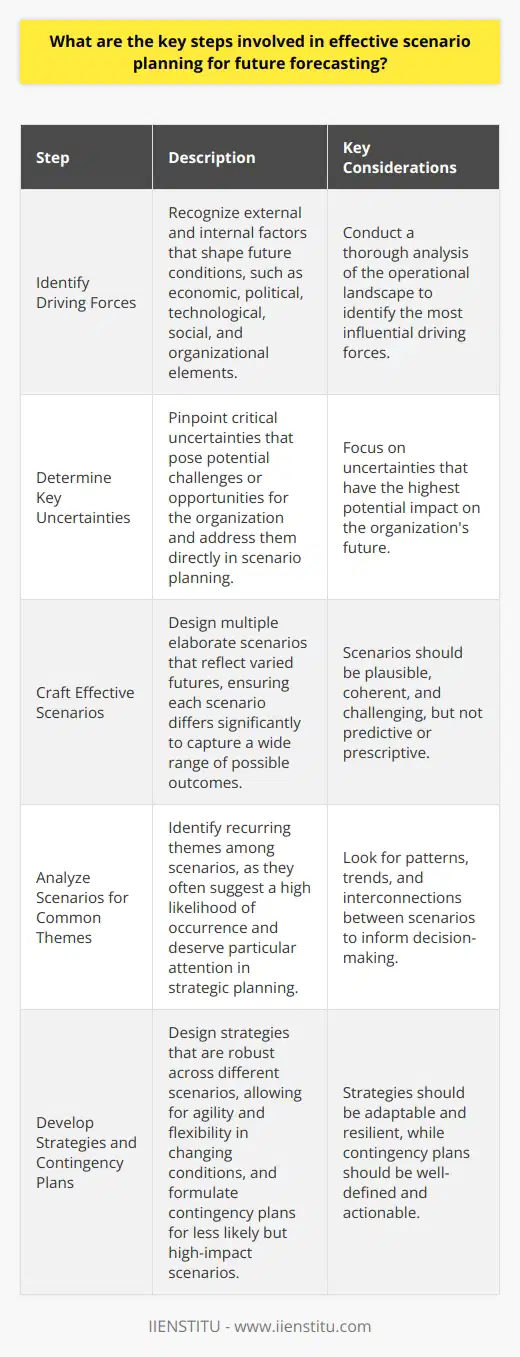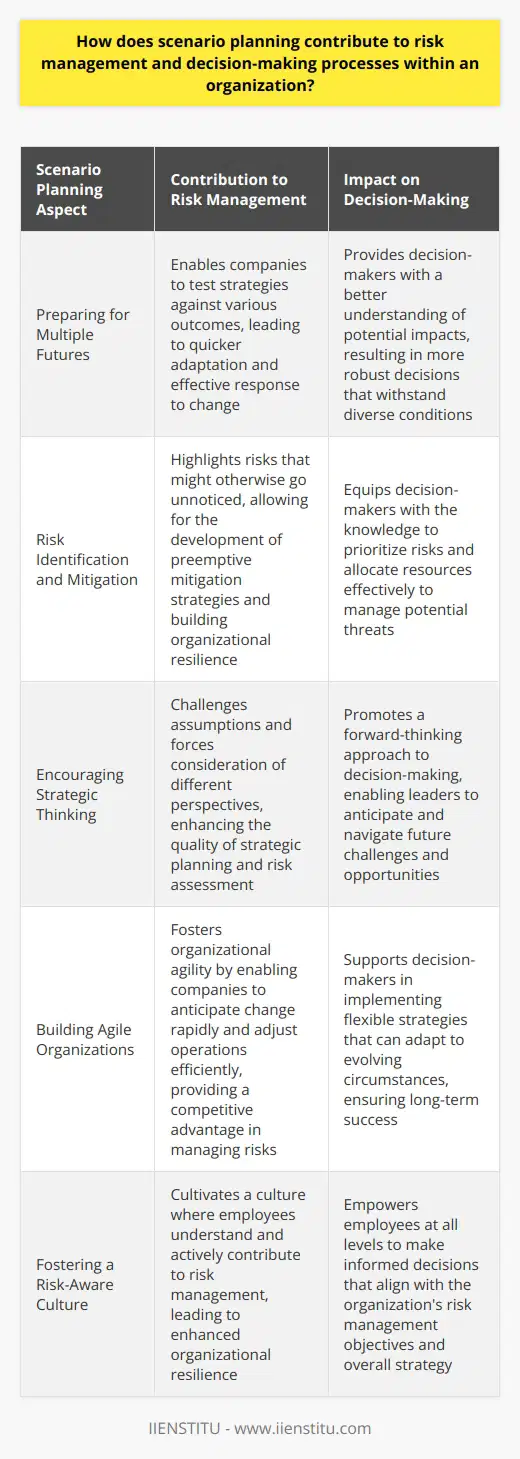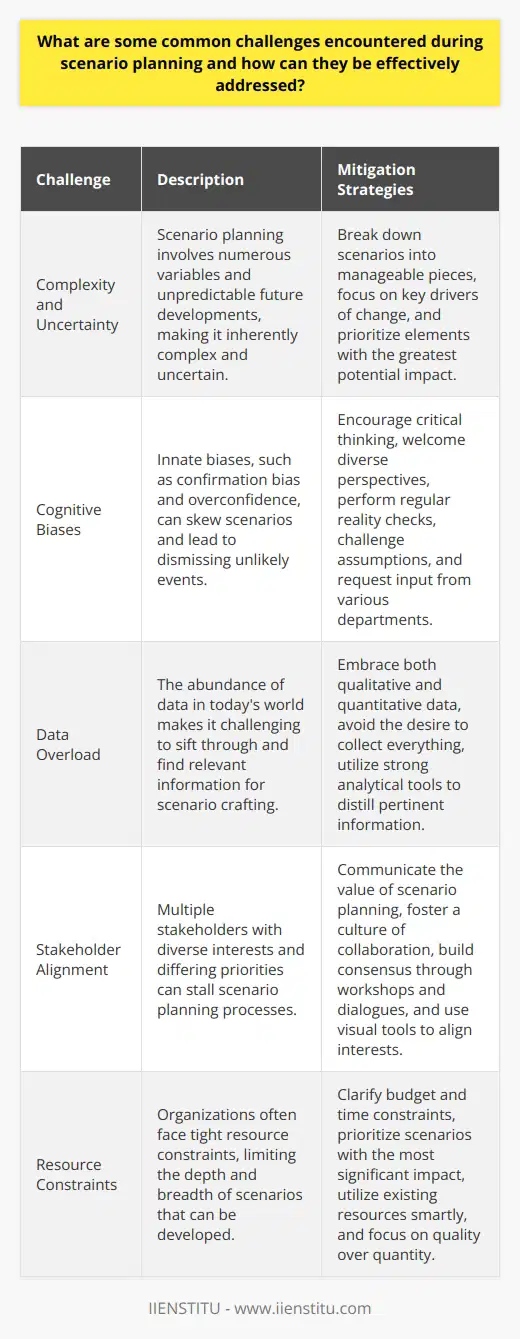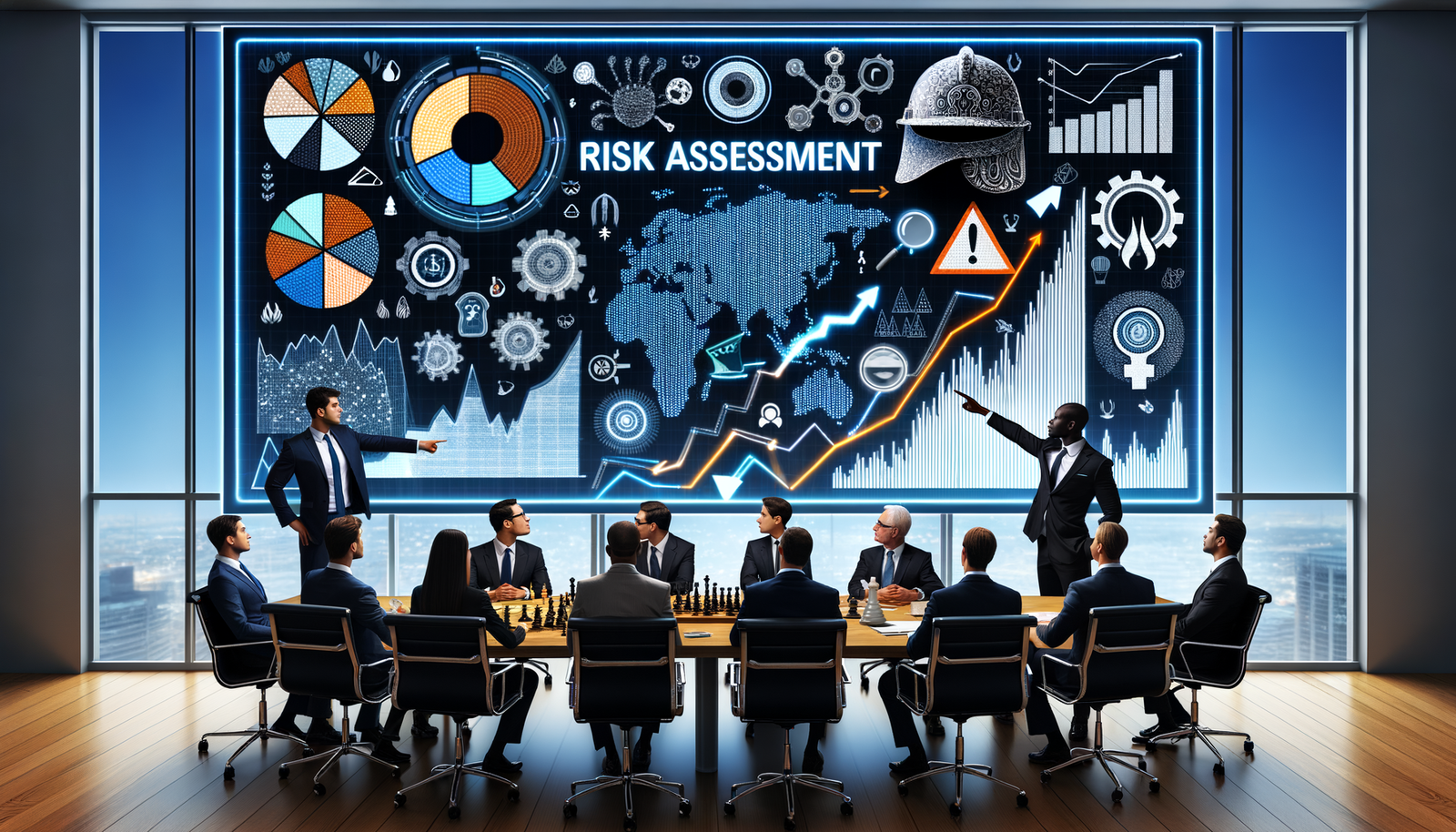
In an increasingly volatile and complex business landscape, the ability to anticipate and prepare for future challenges is invaluable. Scenario planning serves as a strategic tool that allows organizations and individuals to explore and understand potential futures and develop strategies in response to a range of possible outcomes. This experiential article will delve into the intricacies of scenario planning, offering insights into its methodology, significance, and practical execution. Furthermore, by exploring real-world applications, the article will demonstrate how scenario planning is pertinent across various industries, aiding in learning problem solving and decision-making processes. Whether you're a business leader, policy maker, or an individual interested in personal development, understanding scenario planning is instrumental for navigating the uncertainties of tomorrow.
Introduction to Scenario Planning
Explanation of Scenario Planning
Scenario planning is a strategic method used to envision and plan for the future by considering different scenarios that could unfold. This tool helps businesses and organizations to anticipate change, examine uncertainties, and make informed decisions. It involves creating a set of plausible futures, each based on distinct assumptions and variables that could impact the organization’s trajectory. By preparing for various possibilities, entities can remain agile and responsive to change, enhancing their resilience and agility.
Importance of Scenario Planning
In the ever-changing world of business, scenario planning stands out as an essential component in the strategic toolset. It is crucial for risk management, enabling organizations to prepare for unexpected events, such as economic shifts, technological advancements, or geopolitical changes. Through the artful investigation of potential futures, scenario planning empowers organizations to avoid the perils of shortsightedness and the complacency that comes with a "business as usual" mentality. Ultimately, it encourages proactive rather than reactive strategies, positioning entities at the vanguard of adaptability and innovation.
Overview of the Blog
The ensuing discourse will present a comprehensive look at scenario planning, underscoring its key concepts, methodologies, and impact factors. We will also discuss the role of uncertainties and diverse perspectives along with practical steps for effective implementation. Alongside these frameworks, the examination of common pitfalls and mitigation strategies will provide a richer understanding of the process. The culminating sections will share a case study exemplifying scenario planning's value in business, followed by a summation of our learnings.
Understanding the Fundamentals of Scenario Planning
Key Concepts
Core elements of scenario planning include the identification of driving forces, trends, and uncertainties that are likely to shape the future. These factors are analyzed and combined in numerous ways to create a series of divergent but plausible scenarios that represent different futures. The emphasis is on breadth of perspective, drawing on a multitude of data sources, experiences, and expert insights to challenge conventional wisdom and stimulate innovative thinking.
Methodology of Scenario Planning
The process of scenario planning is systematic and iterative. It begins by clearly defining the scope and objectives of the exercise. This is followed by environmental scanning, where current and potential influences on the future state are collected. Subsequently, key drivers of change are prioritized to construct the foundational axes of different scenarios. These axes help in creating vivid narratives for each scenario, prompting strategic conversations about how to navigate each potential future.
Factors Impacting Scenario Planning
Multiple components influence the efficacy of scenario planning. These range from the quality of data utilized, stakeholder engagement, the breadth of perspectives considered, and the flexibility of the organization's strategic thinking. Additionally, the cultural and cognitive biases present within a planning team can affect the objectivity and range of scenarios developed, thus the process must be managed with a keen awareness of these potential limitations.
The Role of Uncertainties in Scenario Planning
Effect of Uncertainties on Scenario Planning
Uncertainties are intrinsic to the future, and they play a pivotal role in scenario planning. By analyzing variables that are uncertain and out of control, such as geopolitical changes or natural disasters, scenario planning allows individuals and organizations to not only prepare for the future but also to influence it to a certain extent. The task of distinguishing between what can be controlled and what must be adapted to is vital in navigating strategic pathways.
Strategies to Deal with Uncertainties
To manage uncertainties within scenario planning, it is recommended to establish monitoring systems that track the signs of emerging trends and changes. Additionally, creating flexible strategies that can be adapted in response to unfolding events is fundamental. This requires organizations to develop a culture of agility and continuous learning, where assumptions are regularly questioned, and strategies are revised.
Importance of Diverse Perspectives in Scenario Planning
Role of Multiple Perspectives
A3 Problem Solving İn Agile Methodology İmplementation Examples
Round-robin Brainstorming Techniques For Generating İmpactful İdeas Efficiently
Integrating a range of perspectives is not only beneficial but crucial for robust scenario planning. The collective intelligence that arises from diverse teams can shed light on blind spots and introduce fresh ideas. It ensures that the scenarios developed are not just reflections of a single worldview but incorporate a more holistic understanding of potential futures.
The Limitations of Single Perspective
Relying on a single perspective can lead to narrow, biased scenarios that fail to encompass the complexity of future possibilities. Such an approach might overlook critical signals or emerging trends, ultimately undermining the effectiveness of the strategic planning process. The inclusion of a wide array of stakeholders, therefore, is not merely a tokenistic gesture but a strategic imperative.
Practical Steps in Scenario Planning Process
Step-by-step Guide to Scenario Planning
The scenario planning process can be broken down into key phases. First, there is the preparatory work of defining objectives and scope. Then comes the gathering and analysis of information, which leads to the identification of critical uncertainties and the development of scenario frameworks. The scenarios are then fleshed out with narratives and implications. Following this, strategies are formulated, and preparations are made for the scenarios considered most impactful or likely. Finally, there is a phase of constant review and adaptation, where the scenarios and strategies are adjusted as the real world unfolds.
Tools and Techniques
Various tools and techniques can facilitate scenario planning. Software and databases provide a wealth of information and trend analysis capabilities. Workshops and brainstorming sessions are valuable for the generation of ideas and the construction of narratives. Additionally, methods such as the Delphi technique, where expert opinions are converged through multiple iterations of anonymous surveys, can refine the insights used for scenario building.
Balancing Future Possibilities and Contingencies
Weighing Probabilities against Possibilities
It is critical to balance the consideration of highly probable events with more speculative possibilities. While it may seem practical to focus on what appears more likely, scenario planning gains value from its ability to capture a range of outcomes, including outlier events that could have significant impacts if they were to occur.
Formulating Strategies for Multiple Outcomes
Strategizing for multiple outcomes ensures that an organization is not caught off-guard by less anticipated events. This entails developing flexible and adaptable strategies that can enable a swift and effective response to various scenarios as they begin to manifest in reality. It's about preparedness and agility, aligning resources with an eye to multiple horizons.
Case Study: Scenario Planning in Business
A Real-life Example
One example of successful scenario planning in the business world is Royal Dutch Shell's response to the 1973 oil crisis. The company's scenario planning efforts in the preceding years had considered a situation where Middle Eastern countries restricted oil exports. When the scenario materialized, Shell was able to respond more effectively than its competitors, demonstrating the practical value of the exercise.
Application of Scenario Planning in Different Fields
Beyond the business sector, scenario planning has valuable applications across a myriad of fields, including public policy, healthcare, education, and more. For instance, governments use scenario planning for long-term policy-making, considering factors like population growth, climate change, and technological advancement. It allows for the creation of resilient and future-proof policies.
Pitfalls of Scenario Planning and Mitigation Strategies
Common Challenges and Mistakes
Common pitfalls in scenario planning include the overreliance on historical data, confirmation biases, groupthink, and a lack of follow-through. These challenges can be mitigated through maintaining a critical mindset, actively seeking diverse perspectives, and ensuring ongoing scenario review processes.
Ensuring Robust Scenario Planning
Building scenarios that are truly robust requires a disciplined approach that is transparent, inclusive, and dynamic. Clear communication, regular updates, and the integration of online certificate programs for skill enhancement can all contribute to the continual improvement of the scenario planning process. Training and education in strategic foresight and scenario planning are beneficial for organizations looking to capitalize on this methodology.
Conclusion
Key Takeaways
The article outlined the strategic value and practical execution of scenario planning, a tool that navigates uncertainties and complex futures in multiple domains. We discussed the importance of considering diverse perspectives and managing uncertainties, and we emphasized the necessity of a structured and flexible approach in developing adaptable strategies.
Final Remarks
As the future becomes increasingly unpredictable, the role of scenario planning as a tool for strategic forecasting grows ever more critical. By embracing its principles and methodologies, individuals and organizations can better prepare for a range of potential futures, turning uncertainty into an opportunity for learning, adaptation, and growth.
Frequently Asked Questions
What are the key steps involved in effective scenario planning for future forecasting?
Understanding Scenario Planning
Scenario planning aids organizations in anticipating future uncertainties. This strategic method explores possible future events through creating a variety of plausible scenarios. Thus, it supports decision-making in a complex environment.
Identify Driving Forces
Begin with the external and internal driving forces. External forces include economic, political, technological, and social factors. Internal forces reflect the organization's strategic levers and resources. Acknowledge these elements as they shape future conditions.
Determine Key Uncertainties
Pinpoint critical uncertainties affecting your operational landscape. These uncertainties pose potential challenges or opportunities for an organization. Address them directly in scenario planning.
Crafting Effective Scenarios
Design multiple elaborate scenarios that reflect varied futures. Ensure each scenario differs significantly. This variety captures a wide range of possible outcomes. Remember, scenarios are not predictions but possibilities to consider.
Incorporate Stakeholder Perspectives
Include a diverse range of stakeholder views. Stakeholders provide insights that enrich the scenarios. Their inputs help produce more rounded, believable futures.
Analyze Scenarios for Common Themes
Seek commonalities among scenarios. Recurring themes often suggest a high likelihood of occurrence. They deserve particular attention in strategic planning.
Strategic Implications and Significance
Assess the Impact on the Organization
Consider how each scenario may affect the organization. Impact assessment involves evaluating strategic fit, risk exposure, and adaptive capacity. This step is decisive for future strategy development.
Develop Strategies and Contingency Plans
Design strategies robust across different scenarios. These should allow agility and flexibility in changing conditions. Also, formulate contingency plans for less likely but high-impact scenarios.
Ongoing Monitoring and Reassessment
Establish Indicators for Monitoring
Set up indicators to monitor the business environment. These signals help detect early hints of emerging scenarios. React in a timely manner using these indicators.
Revisit Scenarios Regularly
Update scenarios with new data and insights. The future is dynamic; scenarios must reflect this changing nature. Regular revision ensures they stay relevant and actionable.
Conclusion
Scenario planning is a critical tool for navigating uncertainty. It turns unpredictability into a strategic advantage. Follow these steps for effective scenario planning and remain agile in an ever-changing future.

How does scenario planning contribute to risk management and decision-making processes within an organization?
Scenario Planning in Risk Management
Organizations face uncertainties. These can disrupt plans. Scenario planning is critical. It allows businesses to anticipate possible futures. They prepare for them accordingly. This form contributes significantly to risk management. And also to decision-making processes.
Understanding Scenarios
A scenario is a plausible future. It's not a prediction. Instead, it's a detailed outline. Scenarios consider various factors. Like economic conditions, technological advancements, or social trends. Businesses employ these to navigate uncertainty.
Preparing for Multiple Futures
Scenarios allow for multiple futures. Companies test their strategies against these. This prepares them for various outcomes. They can adapt quicker. And they respond more effectively to change.
Enhancing Decision-Making
Scenario planning informs decision-makers. They understand potential impacts better. They weigh options more carefully. Decisions become more robust. They stand up to a range of conditions.
Risk Identification and Mitigation
Scenario planning highlights risks. These might go unnoticed otherwise. Companies can then develop mitigation strategies. Risks become managed preemptively. The approach builds resilience.
Encouraging Strategic Thinking
This process promotes strategic thinking. It challenges assumptions. It forces consideration of different perspectives. This enhances the quality of strategic planning.
Building Agile Organizations
Agile organizations adapt swiftly. Scenario planning fosters agility. Companies anticipate change rapidly. They adjust their operations efficiently. This gives them a competitive advantage.
Driving Innovation
Preparing for diverse futures sparks innovation. Companies innovate to stay relevant. They find new opportunities for growth. Scenario planning acts as a catalyst.
Assisting in Resource Allocation
Effective resource allocation is crucial. Scenario planning aids in this. It allocates resources to handle potential scenarios. This optimizes investment. And ensures better returns.
Fostering a Risk-Aware Culture
A risk-aware culture is important. Scenario planning fosters this. Employees understand risks. They become risk-aware. They contribute to risk management. This leads to organizational resilience.
Conclusion
Scenario planning is multi-faceted. It involves anticipating, understanding, and preparing. Its role in risk management is unequivocal. The same holds for decision-making. Organizations leverage it for a systematic approach to uncertainty. They prepare better for the future. This supports sustained organizational success.

What are some common challenges encountered during scenario planning and how can they be effectively addressed?
Understanding Scenario Planning
Scenario planning stands as a strategic method. It involves crafting various long-term plans. Managers foresee a range of future possibilities. In doing so, they prepare for the unexpected. Yet, scenario planning isn't without its challenges.
Identifying Key Challenges
Complexity and Uncertainty
One major hurdle is the inherent complexity. Futuristic thinking invites uncertainty. Managers grapple with numerous variables. They can hardly predict every possible development.
Cognitive Biases
People show innate biases. These can skew scenarios. Confirmation bias leads to favoring information that backs pre-existing beliefs. Overconfidence can make one dismiss unlikely events.
Data Overload
Today's world is data-rich. Sifting through vast amounts of information is daunting. Decision-makers face the task of finding relevant data. Irrelevant data can lead to poor scenario crafting.
Stakeholder Alignment
Multiple stakeholders have diverse interests. Getting everyone on the same page is challenging. Differing priorities can stall scenario planning processes.
Resource Constraints
Organizations often work within tight resources. Scenario planning requires both time and financial investment. These constraints limit the depth and breadth of scenarios.
Addressing the Challenges
Simplify Complexity
Break down scenarios into manageable pieces. Stay focused on key drivers of change. Prioritize which elements might have the greatest impact.
Mitigate Biases
Encourage critical thinking. Welcome diverse perspectives. Perform reality checks regularly. Challenge assumptions consistently. Request input from various departments.
Manage Data Effectively
Embrace qualitative and quantitative data. Stay clear of the desire to collect everything. Utilize strong analytical tools. They help in distilling the most pertinent information.
Enhance Stakeholder Engagement
Communicate the value of scenario planning. Foster a culture of collaboration. Build consensus through workshops and dialogues. Use visual tools to align interests.
Optimize Resources
Get clear about budget and time constraints. Prioritize scenarios with the most significant impact. Utilize existing resources smartly. Focus on quality, not quantity, of scenarios.
In conclusion, scenario planning is both vital and challenging. It enables organizations to navigate future uncertainty. An academic approach can guide effective scenario planning. Understand the complexities. Build sound strategies. Be prepared for an ever-changing landscape.



